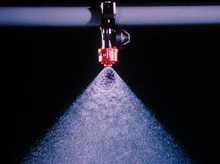 Nozzle tips must be selected according to the spray coverage, droplet size, and application volume desired.
Nozzle tips must be selected according to the spray coverage, droplet size, and application volume desired.
Follow these steps to select a nozzle for a particular application:
Step 1.
Refer to the pesticide label for the recommended spray volume in gallons per acre (GPA) for your situation. The spray volume is the gallons of carrier (water, fertilizer, etc.) and pesticide applied per acre.
Step 2.
Calculate ground speed by traveling 200 feet in the field and using the equation below: Use the average of three test runs for ‘Time’.

Step 3.
Substitute numbers into the following equation to determine flow rate required from each nozzle in gallons per minute (GPM):

Where:
- GPM = gallons per minute of output required from each nozzle
- GPA = gallons per acre desired
- MPH = miles per hour travel speed
- W = effective spray width per nozzle in inches
For broadcasting:
W = nozzle spacing on the boom
For band spraying:

For directed crop foliar spraying:

5,940 = a constant that converts gallons per minute, miles per hour, and inches to gallons per acre
Step 4.
From a nozzle manufacturer’s catalog, select tips that apply the required flow (GPM) in the middle of the desired pressure range.
Example:
You want to broadcast an herbicide at 15 GPA, at a speed of 5 mph, using flat fan nozzles spaced 20 inches apart on the boom. What nozzle tip should you select?
The required flow rate from each nozzle is as follows:

Select nozzles from a manufacturer’s catalog that produce a flow rate at 0.25 GPM when operated within a desired pressure range.
When selecting a nozzle tip it is important to consider the potential for spray drift. A nozzle’s spray pattern is made up of numerous spray droplets of varying sizes. The key to reducing drift is to reduce the number of fine particles, or small-sized droplets, within the spray volume, while still maintaining your spray patterns for even coverage. Refer to the nozzle manufacturer’s catalog for nozzle types that produce a greater percentage of large droplet sizes in the total output from each nozzle over a wide range of pressures.
After installing the selected nozzle tips, make small adjustments in pressure until the desired flow rate is produced. Make sure nozzles are set at the correct spacing, height above the target, and orientation on the boom.
Suggested minimal nozzle heights (inches) for various spray angles and nozzle spacings
|
Spray angle |
20-inch spacing |
30-inch spacing |
|
65 degrees |
21-23 |
33-35 |
|
80 degrees |
17-19 |
24-27 |
|
110 degrees |
10-12 |
14-18 |
Approximate nozzle heights required for various band widths with even flat-fan nozzles
|
Nozzle Height (inches) |
||
|
Band Width (inches) |
80-degree Series |
95-degree Series |
|
8 |
5 |
4 |
|
10 |
6 |
5 |
|
12 |
7 |
6 |
|
14 |
8 |
7 |
|
15 |
9 |
8 |